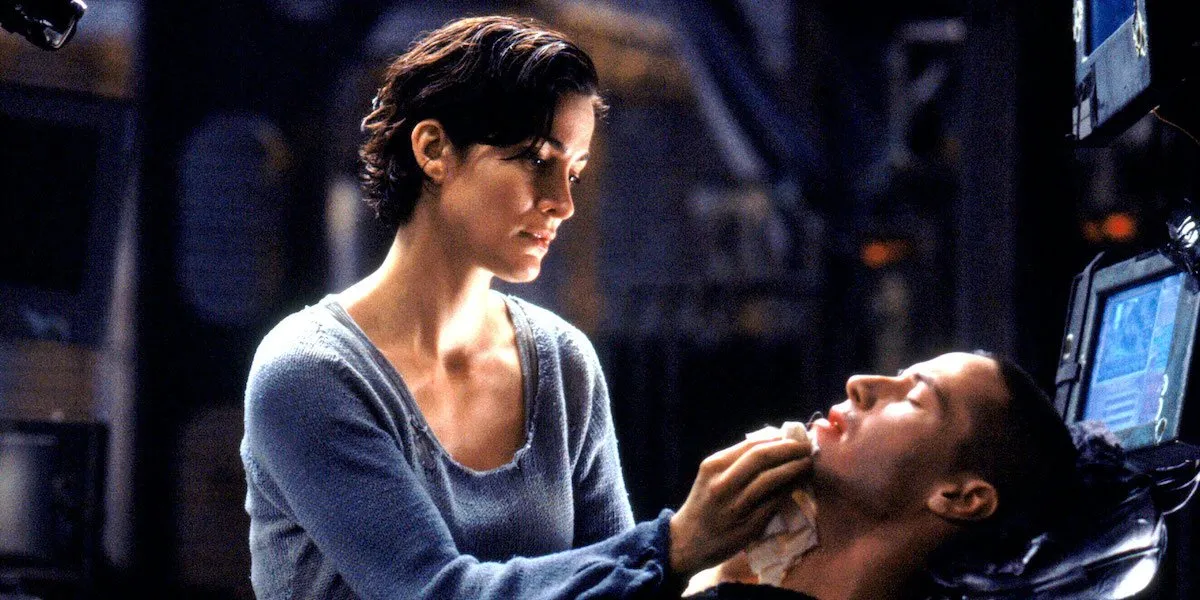In 2016, Lilly Wachowski was forced by an insistent journalist, who was about to out her, to publicly announce her transgender identity. She chose to do so in the pages of the Windy City Times, “the voice of the LGBTQ+ community in Chicago since 1985,” with an open letter focused on her frustration over this invasion of privacy and her experience with transitioning. In particular, Lilly admitted to struggling with understanding queer theory, as much as identity itself, except for one quote by theorist José Esteban Muñoz:
“Queerness is essentially a rejection of the here and now and an insistence on the potentiality of another world.”
It’s hard, if not impossible, to read these words and not see the parallel to Neo’s journey, especially in the first chapter of The Matrix. With the choice of the red pill, the character played by Keanu Reeves rejects the world he knows, his hic et nunc, to open his eyes and discover the reality beyond the neuro-simulation he has lived in up to that point.

The first rejection Neo makes is that of his legal name, the identity under which he lives in the Matrix when he has to deal with society as conventionally understood. Thomas Anderson is effectively a role played by Neo, a model citizen who knows and respects the rules, without upsetting anyone. The night allows Neo to move freely, away from the constant scrutiny of society and to challenge the system from its foundations. The only instance in which his deadname returns is in Matrix: Resurrections, when a (re)conversion therapy based on blue pills traps Neo in the Matrix.
Following the name is an even more radical rejection: that of the body. In The Matrix, the body is by nature limiting, a flesh prison that oppresses the mind and its potential. The key to living, as announced by Morpheus (Laurence Fishburne), is to free the mind, abandoning all those sensations capable of inhibiting it such as fear, doubt, and disbelief. Only then can one embrace their potential. In the Matrix saga, the most extreme and perhaps fairy-tale-like form of liberation is flying, which has the same consequences as the red pill. Seeing someone fly means questioning the rules of the world lived in so far and seeking something more.
Neo’s discomfort in the Matrix, the continuous and irritating sensation that something is out of place, resembles the gender dysphoria experienced by many trans people before, during, and after their transition. Throughout the main trilogy, Neo takes control of his life and shapes it as it should be for him. Once free, returning to the Matrix would only mean regression, denying oneself and one’s chance at freedom.
Despite being made years before the Wachowski sisters’ public transition, or as Lana preferred to describe it “evolution,” The Matrix has been, since its debut twenty-five years ago, one of the most explicitly trans works in history. This isn’t merely a reinterpretation due to the experience of the authors and directors, but rather an allegory present from the beginning and explicit to anyone who had similar experiences.

In an interview with The Hollywood Reporter, Lilly explained how The Matrix was born out of “a deep anger towards capitalism, corporations, and all forms of oppression,” but that sentiment had an even more personal origin: “The bubbling anger in me came from my own oppression, from my forcing myself to stay in the closet.” The allegory would have been even more explicit if, as initially thought by the Wachowski sisters, the character of Switch had been portrayed by a man in the real-world scenes and by a woman (Belinda McCrory, the actress in the film) in the Matrix. The idea, halted by Warner Bros., remains suggested in the film thanks to a character easily interpretable as gender-fluid in their expression.
The trans reading of The Matrix, however, is not the only possible interpretative path. There, in Neo’s pills, where trans people saw, jokingly (but not too much), the choice between estrogen and testosterone, some internet communities saw the need for counter-information, a need to reject what the media said to build their own reality resisting external forces that threaten it. The so-called “red-pilled” believe they know better than anyone else how society and interpersonal dynamics really work, especially if intersected with gender. From the manipulation of Neo’s legend, there arose the need to make a final film, one that many critics and fans have called a commercial and creative suicide. Matrix: Resurrections is a film-explanation in the most essential sense of the term: it makes the allegory the very substance of the story and retraces the real reasons that led to the need for The Matrix.
The moment where this frustration becomes most explicit is when Bugs, a rebel belonging to the Resistance, tells Neo how much his story, so important to her and her people, has been trivialized by the Matrix that shaped it for its purposes and transformed it from a source of hope into a weapon. Matrix: Resurrections represents for the Wachowski sisters (even if the last chapter bears only Lana’s signature) a way to reclaim Neo’s story, to free it from the jaws of capitalism and those who have chosen to plagiarize it to perpetrate violence. If you strip The Matrix of its action, what remains is a story of identity and community search, the desire for a world where the status quo does not oppress people. Twenty-five years after its release, the first film remains a lucid analysis of both the present we are living and the future that is approaching.
Perhaps a red pill will suffice to discover if we too are living in The Matrix.
Giada Sartori
Birdmen, March 31, 2024

